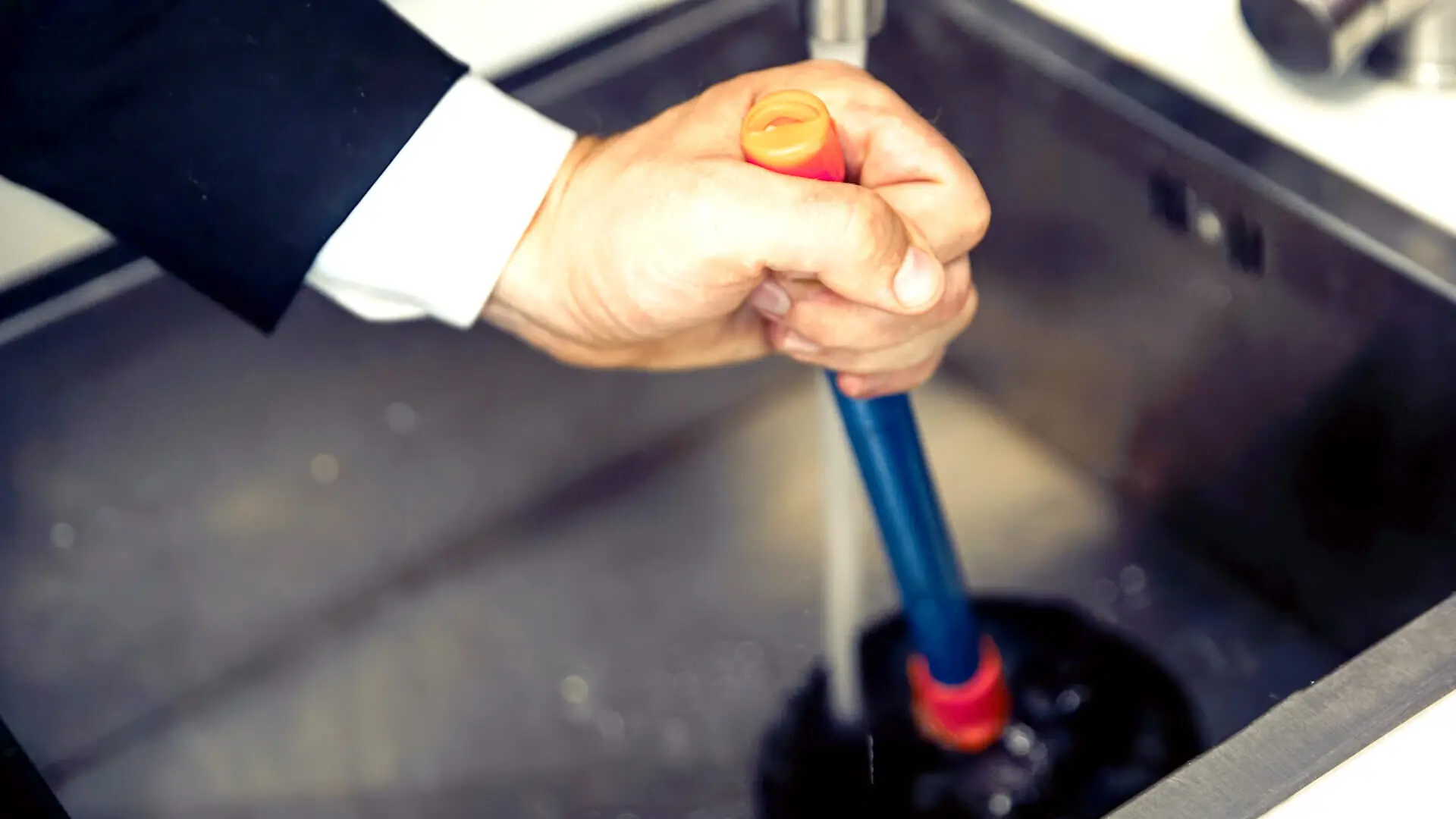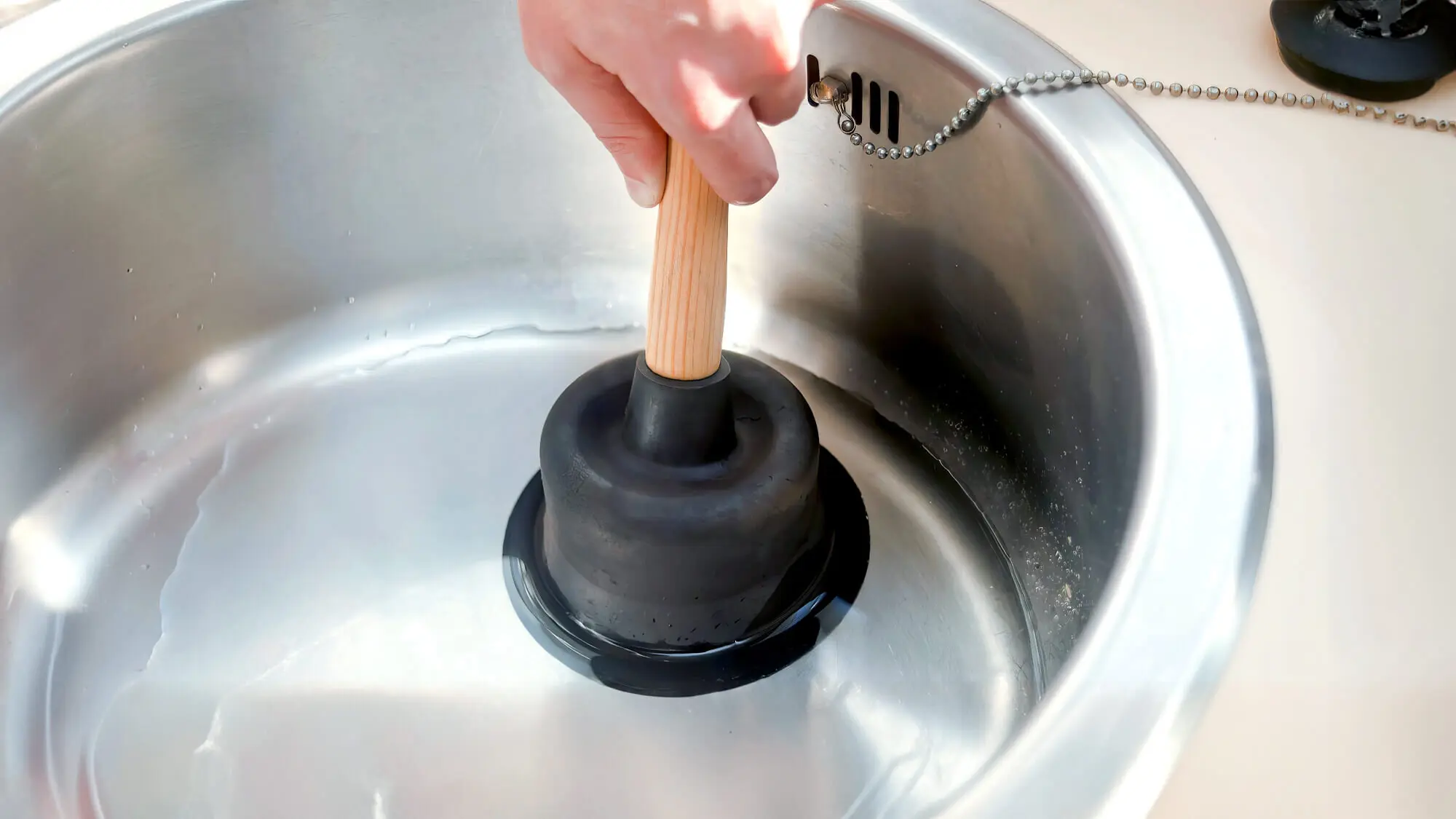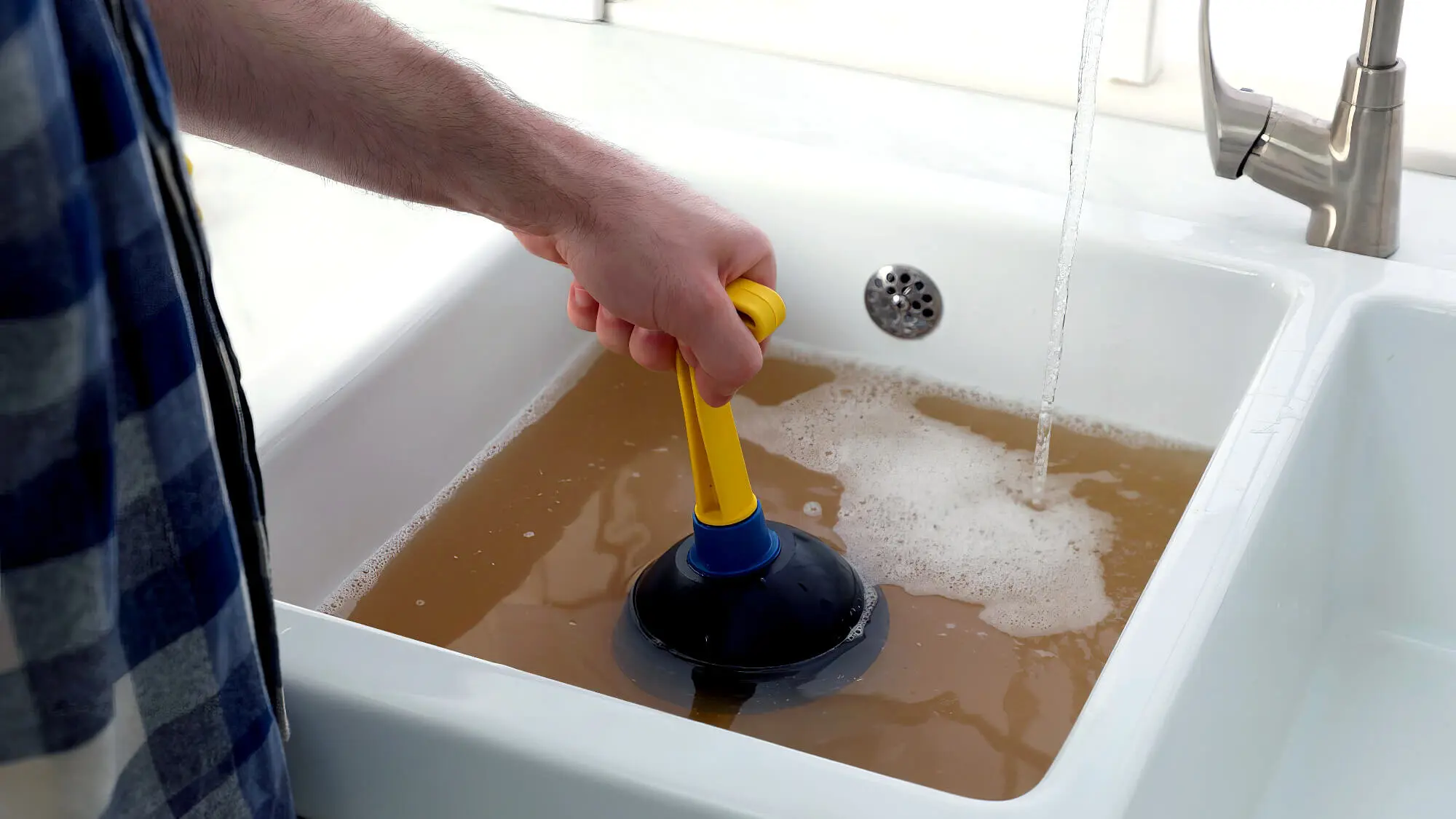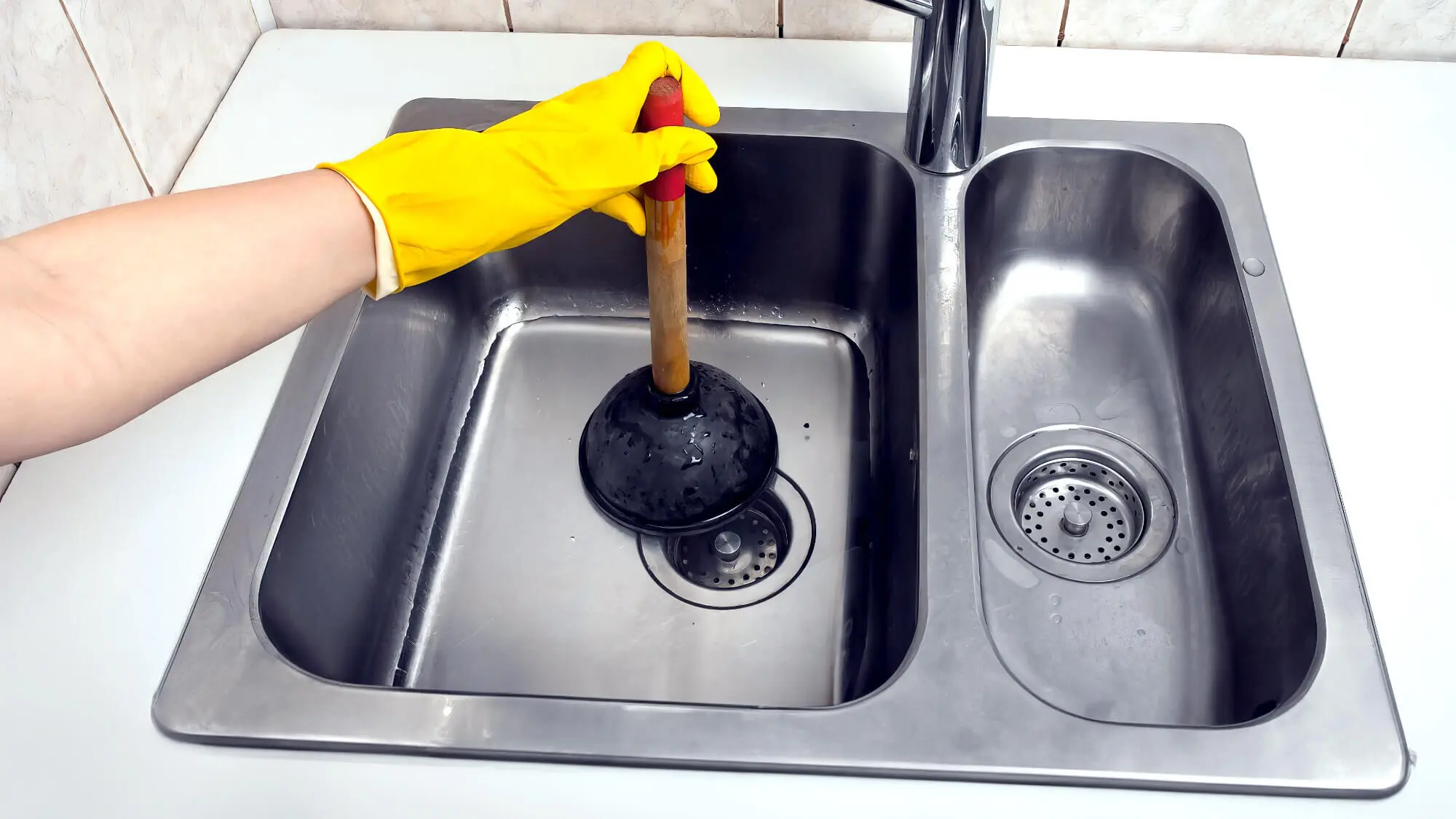Facing a clogged kitchen sink can bring your meal prep to a screeching halt.
Food scraps, grease, and other debris can build up, leading to a slow drain or even a full blockage. Before calling in the pros or reaching for harsh chemical cleaners, why not give the trusty plunger a go?

The plunger is your first mate against a clogged sink drain. Unlike toilet plungers, sink plungers are crafted for flat surfaces to form a solid seal. They’re affordable and straightforward, ideal for dealing with usual kitchen sink clogs.
However, if your plunging efforts prove ineffective, there might be a deeper clog or even a problem with the pipes themselves. It’s best to call a professional plumber with their trusty drain snake to clear the blockage in these situations.
Choosing the Right Plunger
Picking the right plunger is essential when you’re dealing with a clogged sink drain. It can make all the difference.

Flange Plunger
A flange plunger is an ideal choice for kitchen sinks, thanks to its wide, flat flange that creates a tight seal over the drain opening.
This seal is essential for effectively using air pressure to unclog drains. Flange plungers, typically made of rubber or plastic, are designed to fit snugly over the drain hole, even in a double sink.
Accordion Plungers
While accordion plungers exist, they are best suited for toilets and not recommended for sinks. For stubborn clogs, such as those caused by food particles or coffee grounds, a combination of a flange plunger and hot water can be effective.
Pouring boiling water down the drain and using a wet rag to block the overflow hole can enhance the plunger’s efficiency.
Other Tools
A drain snake or a pipe wrench might be necessary to access the drain trap. Sink plungers or cup plungers can help manage standing water in bathroom sinks and shower drains. Chemical drain cleaners or a mixture of baking soda and vinegar can also be used, but be cautious, as they might damage the plumbing system.
Whether it’s a blocked sink, a clogged toilet, or a shower drain, using the correct plunger and method is vital to maintaining a healthy plumbing system.
Preparing for Effective Plunging
A clogged drain can bring your plumbing system to a screeching halt. Standing water in the bathroom sink, a sluggish shower drain or a blocked kitchen sink calls for a plumbing specialist.
But before you reach for the phone and call a professional plumber, there’s a trusty weapon in your arsenal: the humble sink plunger. However, to truly unleash its potential, you need to prepare the following:

Gather your supplies
First things first, assemble your drain-clearing cavalry. You’ll need a plunger — a flange one for flat surfaces like sinks and a cup plunger for toilets — along with a bucket, hot water, baking soda, and perhaps some vinegar (optional).
Clear the Drain Area
Before plunging, it’s crucial to clear the sink drain area. Remove any dishes, food particles, or objects that might hinder your plunging efforts.
Check for Overflow Holes
Sinks often have overflow holes designed to prevent water from flooding the countertop in case of a blockage. You must create a tight seal over this overflow hole to maximise plunging effectiveness. A wet rag works well, or you might have a dedicated overflow hole plug you can use.
Deal with Double Sinks
For double sinks, a slightly different strategy is needed. With one drain clogged, water can still flow freely through the other. Block the unused drain opening with a wet rag or a dedicated sink stopper to create a proper seal. This prevents air from escaping, focusing the plunging force on the blocked drain.
The Plunging Technique
We know a plunger is a straightforward tool that can often clear stubborn sink clogs. Let’s look at how to use it effectively:

Creating a Seal
For optimal performance, you’ll need a good seal. Place the plunger cup (the rubber bit at the end) directly over the drain hole. Some bathroom sink models have an overflow hole.
If yours does, block it with a wet rag to ensure pressure builds within the drain trap, the curved section beneath the sink that traps debris and prevents sewer gases from entering your home.
The Plunging Motion
Don’t choose rapid, shallow plunges. Instead, focus on firm, forceful compressions. Aim for 10-12 plunges per set. Strong, controlled plunges create pressure waves that travel down the drain, dislodging the blockage.
Breaking the Suction
After each set of plunges, it is crucial to break the suction slowly. This prevents a geyser of nasty sink clog material from erupting from the drain hole! Simply lift the plunger cup straight up to release the suction gently.
Repeat and Assess
Repeat the plunging process in sets of 10-12, checking the water flow after each attempt. If hot water isn’t enough, you can try pouring a kettle of boiling water down the drain (be careful not to burn yourself!).
As a last resort, before resorting to chemical drain cleaners, consider a natural cleaning method. A mixture of baking soda and vinegar can sometimes help clear blocked drains, but it’s important to note this method may not be as effective for particularly stubborn clogs.
Remember, the plunging technique is most effective for removing soft blockages like hair and soap scum. If your blocked drain persists, it might be time to call a professional plumber.
Alternative Techniques
A clogged drain can be a real pain, but before you reach for the harsh caustic chemicals, consider some safer and more natural methods. Here are a couple to try:

Hot Water for Greasy Clogs
For greasy clogs, particularly common in kitchen sinks, try pouring hot water down the drain. Not boiling hot water, but rather hot tap water. This can help melt and loosen grease buildup that might be causing the blockage.
Boil a kettle of water if your tap doesn’t get very hot, but be careful not to pour boiling water directly down the drain — it could damage your pipes.
Baking Soda and Vinegar for Fizzing Action
Baking soda and vinegar can be a powerful combination for a more stubborn clog. Wear rubber gloves for this method, as the mixture can fizz quite a bit. Pour half a cup of baking soda down the drain, followed by a cup of vinegar.
The mixture will fizz as it reacts, helping to break down soap scum, hair, and other organic materials that might be causing the clog. Leave it to sit for at least 30 minutes, then flush with hot water.
Safety First!
These methods are great for localised clogs, but if you’re facing a blocked toilet bowl or suspect a deeper blockage in the drain pipe, it’s best to call a plumber. When using a plunger, use a cup plunger designed for sinks, not a plunger with a wider rubber cup.
It’s important to wear rubber gloves for any drain cleaning method to protect your hands from bacteria and any cleaning agents.
Remember: Avoid using excessive force. If you feel resistance while plunging, don’t force it. You might damage the pipes or loosen the slip nuts that connect them.
Other methods might be needed for really stubborn clogs. A drain snake (also called an auger) can be inserted into the drain to remove the blockage physically.
You can find these at most hardware stores, but follow the instructions carefully and turn the auger clockwise to avoid damaging the drain.
If these methods don’t work, it’s time to call in a professional. They can diagnose the problem and use specialised tools to clear the blockage without damaging your drains.
Preventative Measures for a Clog-Free Sink
Keeping your sink clog-free boils down to adopting good habits and simple maintenance routines. Here’s how to keep your kitchen sink draining smoothly.
Habit Hacks
- Food catcher is your friend: Invest in a mesh strainer that fits snugly over the sink drain. This catches food scraps before they can slide down, potentially creating a deeper clog in the pipes. Regularly empty the strainer into the bin.
- Coffee grounds go in the garden, not the sink: Coffee grounds, eggshells, and other food waste can build up in your pipes over time. Scrape leftover food into a compost bin or rubbish bag instead of rinsing it down the drain.
Maintenance Magic
- Bicarbonate soda and vinegar: Once a month, pour half a cup of baking soda down the drain, followed by a cup of white vinegar. The mixture will fizz and help break down soap residue and mild blockages. Flush the drain with hot water afterwards.
- The power of the plunger: Every few months, use a plunger to dislodge any built-up gunk. For best results, fill the sink with enough water to cover the rubber cup of the plunger completely. Plunge firmly and steadily for several pumps, ensuring a good seal around the overflow opening. If you don’t have a sink plunger, a toilet plunger can be used in a pinch, but disinfect it thoroughly afterwards to avoid cross-contamination.
Product Picks
- Drain screens: A fine-mesh drain screen placed inside the p-trap (the curved section of pipe under the sink) can catch hair and other debris before they enter the main drainage system. These are easily removable for cleaning.
- Zip it up: For stubborn clogs, a zip-it drain cleaner can be a handy tool. This long, plastic cable with a barbed end can be inserted into the drain to snag and remove hair and other blockages. Be sure to follow the manufacturer’s instructions carefully to avoid damaging your pipes.
Common Mistakes to Avoid
A common blunder is using a toilet plunger on your sink. Toilet plungers feature wider cups meant for toilet bowls, covering the overflow completely.
However, it would be best to have a cup plunger with a shallower cup for kitchen sinks to create a proper seal over the sink drain.
First, check for a good seal. Place the cup plunger directly over the sink drain and press firmly to create suction. Ensure that the plunger completely covers the drain to form a good seal. Avoid vigorous, erratic plunges, which can dislodge the blockage and push it further down the pipes.
Instead, use controlled pushes and pulls to effectively clear the clog. You can fill the sink with a few inches of water to improve the seal and reduce splashing. This added water helps create better suction when plunging.
If you’re worried about splashing, pour a bucket of boiling water into the sink first. The heat can help loosen some blockages, and the water level creates a better seal for the plunger. Do not shove coat hangers or makeshift tools down the sink drain, as these can damage your pipes and make the problem worse.
If plunging fails, you might need to use a plumbing snake, but it’s best to call a professional plumber for stubborn clogs.
Remember, using the right plunger and technique can save you from a messy, frustrating experience. So, avoid these common mistakes, and you’ll have a clear sink in no time!
Keep Your Kitchen Sink Flowing Smoothly
Knowing how to use a plunger effectively on your kitchen sink can save you time and frustration. It is also crucial to understand the components of your sink’s drain system and the common causes of blockages.
When dealing with a stubborn clog, selecting the right plunger, preparing properly, and applying the correct techniques can make all the difference.
Proper plunging techniques involve creating a tight seal and maintaining consistent pressure.
If plunging doesn’t resolve the issue, alternative methods and regular maintenance can help prevent future clogs. Avoid common mistakes, such as using excessive force or incorrect plunging methods, to keep your sink functioning smoothly.
When dealing with a particularly tough blockage or if you prefer professional assistance, contact Big Blue Plumbing. Our team of experts specialises in blocked kitchen sink services, ensuring your sink is clear and functional.
Reach out to Big Blue Plumbing today for expert help and enjoy a hassle-free kitchen sink experience. Contact us through our website or call us directly for prompt, reliable service.
FAQ
Can I use any plunger for my kitchen sink?
No, it’s best to use a flange plunger for sinks. Unlike a cup plunger used for toilets, a flange plunger has a wider, flat rubber cup that creates a better seal on a flat sink drain.
How much water should be in the sink when I plunge?
Enough water to cover the cup of the plunger (usually 2-3 inches) is ideal. This water helps transmit the plunging force and creates a tighter seal.
My sink has a double basin. What should I do?
Block the overflow hole of the unused basin with a wet rag to prevent air from escaping and ensure proper suction is created on the clogged drain.
The plunger won’t budge! Is it broken?
Not necessarily. If the plunger feels loose, there’s likely an air leak. Check the seal around the drain and ensure all overflow holes are blocked.



